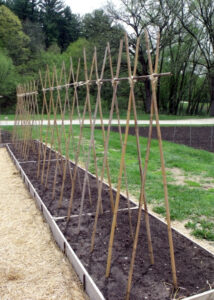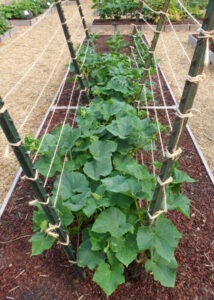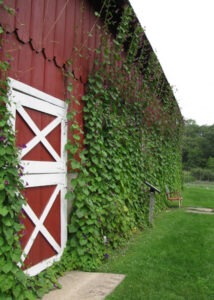Plant Care
Here you’ll find guidance on plant care and the building blocks you'll need for a successful and productive gardens year after year.
What you need to know about plant care; how to prepare transplants, proactive disease and pest prevention, watering tips, and trellis ideas.
When the soil temperatures reach 50-70 degrees and the danger of frost has passed, you are in the clear to plant most transplants outdoors.
While you may be eager to start digging in the garden soil, transplants need time to acclimate to the outdoor elements through a process called hardening off. This vital process gradually exposes seedlings to natural elements in order to ease them into the outdoor environment.
Set the transplants outdoors in a sheltered area (like by a fence, under a tree, or alongside a building), protecting them from intense sun and wind. Gradually expose them to more sunlight and less shelter, allowing them to acclimate to the natural elements. Increase the amount of time plants spend outdoors each day as well. Keep the soil moist at all times during the hardening-off period.
Now that you’ve hardened off your plants, they’re ready to transplant. According to the Old Farmers Almanac, “transplanting” means moving seedlings from pots inside to garden soil outside. When transplanting, be sure to follow these steps:
Keep in mind that the key to moving your seedlings successfully into the great outdoors is taking your time. Don’t rush the process, and soon enough you will be reaping the rewards of a beautiful and bountiful garden.
Managing and preventing disease in the garden is not a simple task, especially because diagnosing plant disease can be difficult. Plant diseases can also be transmitted in a variety of ways—through the soil, the leaves, or even from seeds depending on the disease. And just like human illnesses, there are different types of diseases, which includes fungal, bacterial, or viral. The simplest way to manage plant disease is to take measures to prevent it in the first place.
In an integrated, ecological disease-management system, it’s best to explore cultural options of disease control before turning to chemical ones. Cultural methods include choosing disease-resistant varieties, practicing crop rotation, using drip irrigation, and maintaining proper sanitation (such as removing plant debris from the field).
For more tips on how to keep your plants healthy, check out “10 Garden Pest Solutions” and “How to Build an Inexpensive but Effective Deer Fence.” To learn how to protect fruit trees from pests, check out “How to Prepare Fruit Trees for Winter.”
Watch the video below to learn how Seed Savers Exchange’s Heritage Farm manages greenhouse pests without the use of chemicals.
How much water does my garden need? How often should I water it? When should I water it? Many, even most, gardeners have pondered at least one of these questions. And while proper watering of your garden is not as complicated as it may seem at first glance, there are a few important steps you can follow to ensure your plants have the hydration they need to thrive.
The type of soil you have directly impacts how much water your plants receive. Loam—a combination of sand, silt, and clay particles—absorbs water readily and is able to store it for use by plants. Heavy clay soil often holds too much water—it drains poorly and compacts easily. On the other hand, water runs quickly through sandy soil, leading to rapid drainage that, in turn, requires more frequent watering. Adding organic matter mitigates the problems associated with both sandy and clay soil. Amending soil with compost or other organic matter is also the best long-term strategy for conserving water.
Where and when you water your plants really does make a difference when it comes to plant health and water conservation. Be sure to apply water directly to the soil’s surface. Why? Roots intake water, and plant leaves do not need to be watered. Wet leaves, in fact, only increase the probability that your plants will develop foliar (or leaf) diseases.
Watering in the morning allows leaves to dry quickly (reducing risk of disease) and conserves water.
Watering too shallowly and too frequently are among the most common mistakes gardeners make. Instead, water deeply and thoroughly—doing so encourages roots to push more deeply into the soil, where moisture levels are more consistent. That, of course, means you won’t need to water your plants as often. Remember that newly planted seeds and young seedlings/transplants that have shallow, developing root systems will need to be watered more frequently, whereas established plantings have deeper root systems and require less frequent watering.
Mulching soil around the base of plants reduces moisture loss to evaporation, conserving soil moisture and reducing the time you will spend watering your plants.
Grouping plants with similar watering needs in the garden will both decrease the time you spend watering and increase your ability to allocate water properly. Certain crops (such as onions and lettuce) as well as new plantings need shallow, more-frequent watering, whereas long-season plants like tomatoes need deeper, less-frequent watering.
It’s a good rule of thumb to water your garden when about half the available water in the soil is depleted. But how do you best determine when that is? Try digging down into the soil at least four inches and squeezing a handful of soil into a ball. When compressed in this manner, sandy soil should stick together slightly; loamy soil should form a loose ball; and clay soil should form a ball easily. If this doesn’t happen in each case, it’s time to water your garden.
Maximize space in your garden with trellises. Some crop types—like cucumbers, tomatoes, and pole beans—need the extra support a trellis can provide, and others, like melons and squash, don’t require trellises but can benefit from being lifted off of the ground. When fruits are suspended from a trellis and kept from the soil surface, they are less prone to disease, and going vertical means that plants can grow vertically instead of sprawling, opening up some garden real estate on which to plant other crops. Trellises also have the benefit of making harvesting easier, as produce is at eye level and simpler to find and collect.
Check out some of the trellis solutions we have used at Seed Savers Exchange.



Tina Hall, former bulk seed coordinator at Seed Savers Exchange, discusses French trellising tomatoes in this video from the Resilience Gardens video series. Originally filmed June 2020.